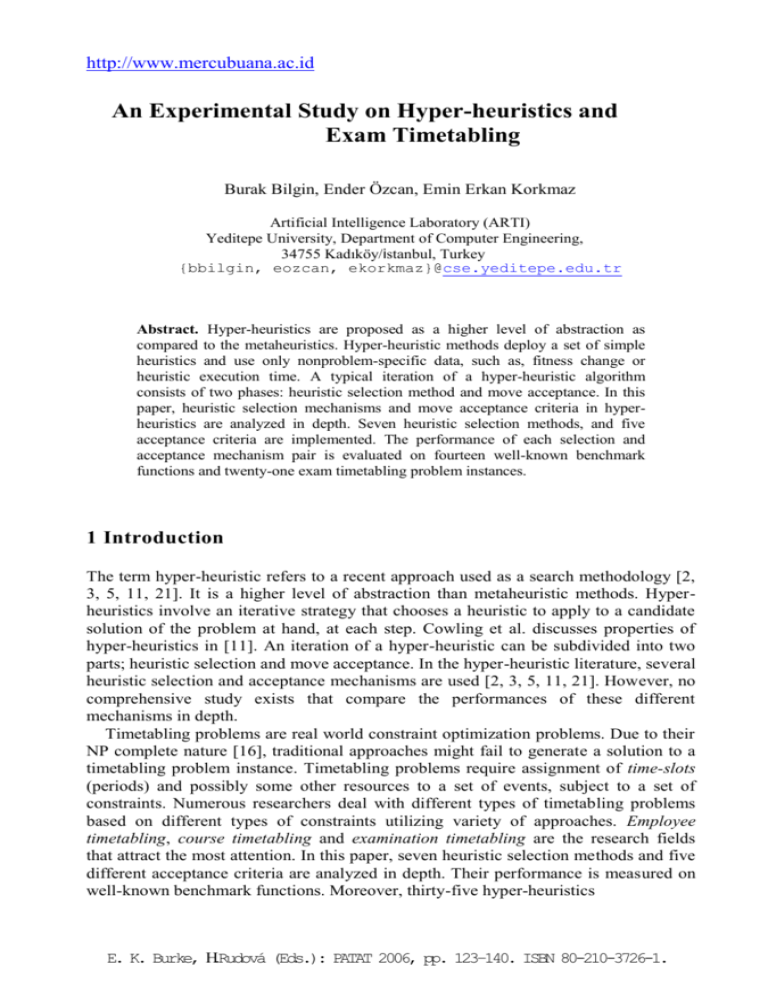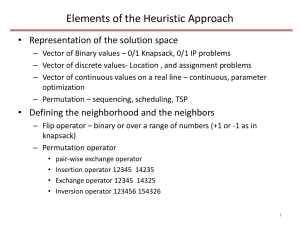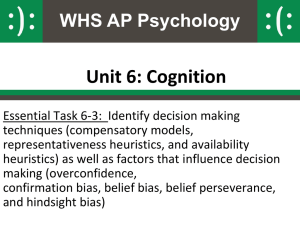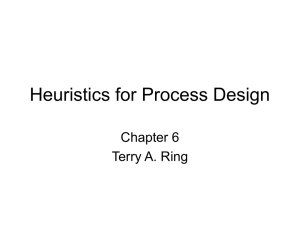An Experimental Study on Hyper-heuristics and Exam Timetabling
advertisement

http://www.mercubuana.ac.id
An Experimental Study on Hyper-heuristics and
Exam Timetabling
Burak Bilgin, Ender Özcan, Emin Erkan Korkmaz
Artificial Intelligence Laboratory (ARTI)
Yeditepe University, Department of Computer Engineering,
34755 Kadıköy/istanbul, Turkey
{bbilgin, eozcan, ekorkmaz}@cse.yeditepe.edu.tr
Abstract. Hyper-heuristics are proposed as a higher level of abstraction as
compared to the metaheuristics. Hyper-heuristic methods deploy a set of simple
heuristics and use only nonproblem-specific data, such as, fitness change or
heuristic execution time. A typical iteration of a hyper-heuristic algorithm
consists of two phases: heuristic selection method and move acceptance. In this
paper, heuristic selection mechanisms and move acceptance criteria in hyperheuristics are analyzed in depth. Seven heuristic selection methods, and five
acceptance criteria are implemented. The performance of each selection and
acceptance mechanism pair is evaluated on fourteen well-known benchmark
functions and twenty-one exam timetabling problem instances.
1 Introduction
The term hyper-heuristic refers to a recent approach used as a search methodology [2,
3, 5, 11, 21]. It is a higher level of abstraction than metaheuristic methods. Hyperheuristics involve an iterative strategy that chooses a heuristic to apply to a candidate
solution of the problem at hand, at each step. Cowling et al. discusses properties of
hyper-heuristics in [11]. An iteration of a hyper-heuristic can be subdivided into two
parts; heuristic selection and move acceptance. In the hyper-heuristic literature, several
heuristic selection and acceptance mechanisms are used [2, 3, 5, 11, 21]. However, no
comprehensive study exists that compare the performances of these different
mechanisms in depth.
Timetabling problems are real world constraint optimization problems. Due to their
NP complete nature [16], traditional approaches might fail to generate a solution to a
timetabling problem instance. Timetabling problems require assignment of time-slots
(periods) and possibly some other resources to a set of events, subject to a set of
constraints. Numerous researchers deal with different types of timetabling problems
based on different types of constraints utilizing variety of approaches. Employee
timetabling, course timetabling and examination timetabling are the research fields
that attract the most attention. In this paper, seven heuristic selection methods and five
different acceptance criteria are analyzed in depth. Their performance is measured on
well-known benchmark functions. Moreover, thirty-five hyper-heuristics
E. K. Burke, H.Rudová (Eds.): PATAT 2006, pp. 123–140. ISBN 80-210-3726-1.
http://www.mercubuana.ac.id
124 B. Bilgin et al.
generated by coupling all heuristic selection methods and all acceptance criteria with
each other, are evaluated on a set of twenty-one exam timetabling benchmark problem instances, including Carter’s benchmark [10] and Ozcan’s benchmark [25].
The remainder of this paper is organized as follows. In Section 2 background is
provided including hyper-heuristics, benchmark functions and exam timetabling.
Experimental settings and results for benchmarks are given in Section 3. Hyperheuristic experiments on exam timetabling are presented in Section 4. Finally, conclusions are discussed in Section 5.
2 Preliminaries
2.1 Hyper-heuristics
Hyper-heuristic methods are described by Cowling et al. [11] as an alternative
method to meta-heuristics. Metaheuristics are ‘problem-specific’ solution methods,
which require knowledge and experience about the problem domain and properties.
Metaheuristics are mostly developed for a particular problem and require fine tuning
of parameters. Therefore, they can be developed and deployed only by experts who
have the sufficient knowledge and experience on the problem domain and the metaheuristic search method. Hyper-heuristics, on the other hand are developed to be
general optimization methods, which can be applied to any optimization problem
easily. Hyper-heuristics can be considered as black box systems, which take the
problem instance and several low level heuristics as input and which can produce the
result independent of the problem characteristics. In this concept, hyper-heuristics use
only non problem-specific data provided by each low level heuristic in order to select
and apply them to candidate solution [3, 5, 11].
The selection mechanisms in the hyper-heuristic methods were emphasized in the
initial phases of the research period. Cowling et al. [11] proposed three types of low
level heuristic selection mechanisms to be used in hyper-heuristics; which are Simple,
Greedy and Choice Function. There are four types of Simple heuristic selection
mechanisms. Simple Random mechanism chooses a low level heuristic at a time randomly. Random Descent mechanism chooses a low level heuristic randomly and
applies it repeatedly as long as it produces improving results. Random Permutation
mechanism creates an initial permutation of the low level heuristics and at each iteration applies the next low level heuristic in the permutation. Random Permutation
Descent mechanism is the same as Random Permutation mechanism, except that it
applies the low level heuristic in turn repeatedly as long as it produces improving
results. Greedy method calls each low level heuristic at each iteration and chooses the
one that produces the most improving solution. Choice Function is the most complex
one. It analyzes both the performance of each low level heuristic and each pair of low
level heuristics. This analysis is based on the improvement and execution time. This
http://www.mercubuana.ac.id
mechanism also considers the overall performance. It attempts to focus the search as
long as the improvement rate is high and broadens the search if the improvement rate
http://www.mercubuana.ac.id
Hyper-heuristics and Exam Timetabling [...]
125
is low. For each of these low level heuristic selection mechanisms two simple acceptance criteria are defined. These are AM, where all moves are accepted and OI where
only improving moves are accepted [11].
Burke et al. [5] proposed a Tabu-Search heuristic selection method. This mechanism ranks low level heuristics. At the beginning of the run each heuristic starts the
execution with the minimum ranking. Every time a heuristic produces an improving
movement its rank is increased by a positive reinforcement rate. The rank of the heuristics cannot exceed a predetermined maximum value. Whenever a heuristic cannot
make an improving move; its rank is decreased by a negative reinforcement learning
rate. Similarly the rank of a heuristic cannot be decreased to a value less than a predetermined minimum value. In the case of worsening moves, the heuristic is also
added to the tabu list. Another parameter is the tabu duration which sets the maximum number of iterations a low level heuristic can stay in the tabu list. The tabu list
is emptied every time there is a change in the fitness of the candidate solution [5].
Burke et al. [8] introduce a simple generic hyper-heuristic which utilizes constructive heuristics (graph coloring heuristics) to tackle timetabling problems. A tabusearch algorithm chooses among permutations of constructive heuristics according to
their ability to construct complete, feasible and low cost timetables. At each iteration
of the algorithm, if the selected permutation produces a feasible timetable, a deepest
descent algorithm is applied to the obtained timetable. Burke et al. used this hyperheuristic method in exam and university course timetabling problem instances. The
proposed method worked well on the related benchmark problem instances [8].
Burke et al. [9] proposed a case based heuristic selection approach. A knowledge
discovery method is employed to find the problem instances and situations where a
specific heuristic has a good performance. The proposed method also explores the
similarities between the problem instance and the source cases, in order to predict the
heuristic that will perform best. Burke et al. applied Case-Based Heuristic Selection
Approach to the exam and university course timetabling [9].
Ayob and Kendall [2] emphasized the role of the acceptance criterion in the
hyper-heuristic. They introduced the Monte Carlo Hyper-heuristic which has a more
complex acceptance criterion than AM or OI criteria. In this criterion, all of the
improving moves are accepted and the non-improving moves can be accepted based
on a probabilistic framework. Ayob and Kendall defined three probabilistic
approaches to accept the non-improving moves. First approach, named as Linear
Monte Carlo (LMC), uses a negative linear ratio of the probability of acceptance to
the fitness worsening. Second approach named as, Exponential Monte Carlo (EMC),
uses a negative exponential ratio of the probability of acceptance to the fitness
worsening. Third approach, named as Exponential Monte Carlo with Counter
(EMCQ), is an improvement over Exponential Monte Carlo. Again, the probability
of accepting worsening moves decreases as the time passes. However if no
improvement can be achieved over a series of consecutive iterations then this
probability starts increasing again. As the heuristic selection mechanism, they all use
simple random mechanism [2].
Kendall and Mohamad [21] introduced another hyper-heuristic method which also
focuses on acceptance criterion rather than selection method. They used the Great
Deluge Algorithm as the acceptance criterion and Simple Random as heuristic selec-
http://www.mercubuana.ac.id
126
B. Bilgin et al.
tion method. In the Great Deluge Algorithm initial fitness is set as initial level. At each
step, the moves which produce fitness values less than the level are accepted. At each
step the level is also decreased by a factor [21].
Gaw et al. [17] presented a research on the choice function hyper-heuristics, generalized low-level heuristics, and utilization of parallel computing environments for
hyper-heuristics. An abstract low level heuristic model is proposed which can be
easily implemented to be a functional low level heuristic tackling a specific problem
type. The choice function hyper-heuristic and the low-level heuristics are improved to
evaluate a broader range of the data. Two types of distributed hyper-heuristic approaches are introduced. The first approach is a single hyper-heuristic, multiple lowlevel heuristics which are executed on different nodes and focus on different areas of
the timetable. The second approach utilizes multiple hyper-heuristics each of which
work on a different node. In this approach, hyper-heuristics collaborate during the
execution [17].
According to this survey it is concluded that several heuristic selection methods
and acceptance criteria are introduced for hyper-heuristics framework. Each pair of
the heuristic selection and acceptance mechanism can be used as a different hyperheuristic method. Despite this fact, such combinations have not been studied in the
literature. In this study, seven heuristic selection mechanisms, which are Simple Random, Random Descent, Random Permutation, Random Permutation Descent, ChoiceFunction, Tabu-Search, Greedy heuristic selection mechanisms, are implemented. For
each heuristic selection method five acceptance criteria: AM, OI, IE, a Great Deluge
and a Monte Carlo are used. As a result a broad range of hyper-heuristic variants are
obtained. These variants are tested on mathematical objective functions and exam
timetabling Problems.
2.2 Benchmark Functions
Well-defined problem sets are useful to measure the performance of optimization
methods such as genetic algorithms, memetic algorithms and hyper-heuristics.
Benchmark functions which are based on mathematical functions or bit strings can be
used as objective functions to carry out such tests. The characteristics of these
benchmark functions are explicit. The difficulty levels of most benchmark functions
are adjustable by setting their parameters. In this study, fourteen different benchmark
functions are chosen to evaluate the hyper-heuristics.
The benchmark functions presented in Table 1 are continuous functions, and Royal
Road Function, Goldberg’s 3 bit Deceptive Function [18], [19] and Whitley’s 4 bit
Deceptive Function [31] are discrete functions. Their deceptive nature is due to the
large Hamming Distance between the global optimum and the local optima. To increase the difficulty of the problem n dimensions of these functions can be combined
by a summation operator.
The candidate solutions to all the continuous functions are encoded as bit strings
using gray code. The properties of the benchmark functions are presented in Tab. 1.
The modality property indicates the number of optima in the search space (i.e. between
bounds). Unimodal benchmark functions have a single optimum. Multimodal
http://www.mercubuana.ac.id
Hyper-heuristics and Exam Timetabling [...]
127
benchmark functions contain more than one optimum in their search space. Such
functions contain at least one additional local optimum in which a search method can
get stuck.
Tab. 1. Properties of benchmark functions, lb indicates the lower bound, ub indicates the
upper bound of the search space, opt indicates the global optimum in the search space
Function, [Source]
Sphere, [13]
Rosenbrock, [13]
Step, [13]
Quartic, [13]
Foxhole, [13]
Rastrigin, [28]
Schwefel, [29]
Griewangk, [19]
Ackley, [1]
Easom, [15]
Rotated Hyperellipsoid,[13]
Royal Road, [23]
Goldberg, [17, 18]
Whitley, [30]
lb
-5.12
-2.048
-5.12
-1.28
-65.536
-5.12
-500
-600
-32.768
-100
-65.536
-
ub
5.12
2.048
5.12
1.28
65.536
5.12
500
600
32.768
100
65.536
-
opt
0
0
0
1
0
0
0
0
0
-1
0
0
0
0
Continuity
Continuous
Continuous
Continuous
Continuous
Continuous
Continuous
Continuous
Continuous
Continuous
Continuous
Continuous
Discrete
Discrete
Discrete
Modality
Unimodal
Unimodal
Unimodal
Multimodal
Multimodal
Multimodal
Multimodal
Multimodal
Multimodal
Unimodal
Unimodal
-
2.3 Exam Timetabling
Burke et al. [4, 6] applied a light or a heavy mutation, randomly selecting one, followed by a hill climbing method. Investigation of various combinations of Constraint
Satisfaction Strategies with GAs for solving exam timetabling problems can be found
in [22]. Paquete et. al. [27] applied a multiobjective evolutionary algorithm (MOEA)
based on pareto ranking for solving exam timetabling problem in the Unit of Exact
and Human Sciences at University of Algarve. Two objectives were determined as to
minimize the number of conflicts within the same group and the conflicts among
different groups. Wong et. al. [32] used a GA utilizing a non-elitist replacement strategy to solve a single exam timetabling problem at École de Technologie Supérieure.
After genetic operators were applied, violations were fixed in a hill climbing procedure.
Carter et. al. [10] applied different heuristic orderings based on graph coloring.
Their experimental data became one of the commonly used exam timetabling benchmarks. Gaspero and Schaerf [14] analyzed tabu search approach using graph coloring
based heuristics. Merlot et al. [23] explored a hybrid approach for solving the exam
timetabling problem that produces an initial feasible timetable via constraint programming. The method, then applies simulated annealing with hill climbing to improve the solution. Petrovic et al. [28] introduced a case based reasoning system to
create initial solutions to be used by great deluge algorithm. Burke et al. [7] proposed a
general and fast adaptive method that arranges the heuristic to be used for ordering
http://www.mercubuana.ac.id
exams to be scheduled next. Their algorithm produced comparable results on a set of
benchmark problems with the current state of the art. Ozcan and Ersoy [25] used a
http://www.mercubuana.ac.id
128
B. Bilgin et al.
violation directed adaptive hill climber within a memetic algorithm to solve exam
timetabling problem. A Java tool named FES is introduced by Ozcan in [26] which
utilizes XML as input/output format.
Exam timetabling problem can be formulated as a constraint optimization problem
by a 3-tuple (V, D, C). V is a finite set of examinations, D is a finite set of domains of
variables, and C is a finite set of constraints to be satisfied. In this representation a
variable stands for an exam schedule of a course. Exam timetabling involves a search
for a solution, where values from domains (timeslots) are assigned to all variables
while satisfying all the constraints.
The set of constraints for exam timetabling problem differs from institution to institution. In this study, three constraints are defined and used as described in [25]:
(i) A student cannot be scheduled to two exams at the same time slot.
(ii) If a student is scheduled to two exams in the same day, these should not be assigned to consecutive timeslots.
(iii) The total capacity for a timeslot cannot be exceeded.
3 Hyper-heuristics for Benchmark Functions
3.1 Benchmark Function Heuristics
Six heuristics were implemented to be used with hyper-heuristics on benchmark
functions. Half of these are hill-climbing methods and the remaining half are mutational operators combined with a hill climber.
Next Ascent Hill Climber makes number of bits times iterations at each heuristic
call. Starting from the most significant bit, at each iteration it inverts the next bit in the
bit string. If there is a fitness improvement, the modified candidate solution is accepted
as the current candidate solution [24]. Davis’ Bit Hill Climber is the same as Next
Ascent Hill Climber but it does not modify the bit sequentially but in the sequence of a
randomly determined permutation [12]. Random Mutation Hill Climber chooses a bit
randomly and inverts it. Again the modified candidate solution becomes the current
candidate solution, if the fitness is improved. This step is repeated for total number of
bits in the candidate solution times at each heuristic call [24].
Mutational heuristics are Swap Dimension, Dimensional Mutation and Hypermutation. Swap Dimension heuristic randomly chooses two different dimensions in the
candidate solution and swaps them. Dimensional Mutation heuristic randomly chooses
a dimension and inverts each bit in this dimension with the probability 0.5.
Hypermutation randomly inverts each bit in the candidate solution with the probability
0.5. To improve the quality of candidate solutions obtained from these mutational
heuristics, Davis’ Bit Hill Climbing is applied.
http://www.mercubuana.ac.id
Hyper-heuristics and Exam Timetabling [...]
129
3.2 Experimental Settings
The experiments are performed on Pentium IV, 2 GHz Linux machines with 256 Mb
memory. Fifty runs are performed for each hyper-heuristic and problem instance pair.
For each problem instance, a set of fifty random initial configurations are created.
Each run in an experiment is performed starting from the same initial configuration.
The experiments are allowed to run for 600 CPU seconds. If the global optimum of the
objective function is found before the time limit is exhausted, then the experiment is
terminated.
The candidate solutions are encoded as bit strings. The continuous functions in
benchmark set are encoded in Gray Code. The discrete functions have their own direct
encoding. Foxhole Function has default dimension of 2. The default number of bits per
dimension parameter is set to 8, 3, and 4 for the Royal Road, Goldberg, and Whitley
Functions respectively. The rest of the functions have 10 dimensions and 30 bits are
used to encode the range of a variable.
3.3 Experimental Results
The experimental results of performance comparison of 35 heuristic selection – acceptance criteria combinations on 14 different benchmark functions are statistically
evaluated. For each benchmark function the combinations are sorted according to
their performance. The average number of fitness evaluations needed to converge to
global optimum is used as the performance criterion for the experiments with 100%
success rate. The average best fitness reached is used for the experiments with success rates lower than 100%. The performances are evaluated statistically using t-test.
Each combination has been given a ranking. Confidence interval is set to 95% in ttest to determine significant performance variance. The combinations that do not have
significant performance variances are grouped together and have been given the same
ranking. The average rankings of heuristic selection methods and move acceptance
criteria are calculated to reflect their performance. In Table 2, average rankings for
the heuristic selection methods are provided on each problem. The averages are obtained by testing the selection methods on each acceptance criteria. In Table 3, average rankings of acceptance criteria are given where the averages are obtained by
testing acceptance criteria on each selection method this time. Lower numbers in
these tables denote a higher placement in the ranking and indicate better performance.
The average ranking of each selection method on all of the functions is depicted in
Fig. 1, and the average ranking of each acceptance criterion on all of the functions in
Fig. 2.
No heuristic selection and acceptance criterion couple came out to be a winner on
all of the benchmark functions. Choice Function performs well on Sphere and
Griewangk functions. Simple Random performs well on Sphere Function. Random
Descent and Random Permutation Descent perform well on Rotated Hyperellipsoid
Function. Greedy performs well on Rosenbrock Function. The performance variances
of heuristic selection methods on remaining functions were not as significant as these
http://www.mercubuana.ac.id
130
B. Bilgin et al.
cases. Choice Function performs slightly better than remaining selection methods on
average. IE acceptance criterion performs well on Rastrigin, Schwefel, Easom, Rotated
Hyperellipsoid, and discrete deceptive functions. OI acceptance criterion performs
well on Rosenbrock Function. MC acceptance criterion performs well on Foxhole
Function. IE acceptance criterion indicates significantly a better performance than the
remaining acceptance criteria on average.
Tab. 2. Average ranking of each selection method on each problem; CF stands for Choice
Function, SR for Simple Random, RD for Random Descent, RP for Random Permutation, RPD
for Random Permutation Descent, Tabu for Tabu Search, GR for Greedy.
Name
Sphere
Rosenbrock
Step
Quartic w/ noise
Foxhole
Rastrigin
Schwefel
Griewangk
Ackley
Easom
Rotated Hyperellipsoid
Royal Road
Goldberg
Whitley
CF
7.0
20.2
17.7
17.9
15.7
17.9
17.0
11.8
16.5
16.0
20.4
16.8
18.6
17.9
SR
7.0
22.0
17.7
17.9
15.7
17.5
17.0
17.2
16.5
16.0
21.2
17.6
19.3
17.9
RD
24.5
16.0
17.7
17.9
15.7
18.5
18.8
17.2
16.5
21.7
13.4
17.1
16.6
17.9
RP
14.0
23.8
18.9
17.9
19.3
17.3
17.0
17.2
23.5
16.0
21.6
17.4
19.4
17.9
RPD
24.5
16.0
17.7
17.9
15.7
18.5
18.8
17.2
16.5
21.7
14.8
17.1
17.4
17.9
TABU
24.5
16.0
17.7
17.9
15.7
17.7
18.8
17.2
16.5
21.7
19.8
17.8
16.1
17.9
GR
24.5
12.0
18.6
18.6
28.2
18.6
18.6
28.2
20.0
12.9
15.6
22.2
18.6
18.6
20
19.5
19
18.5
18
17.5
17
16.5
16
15.5
15
14.5
CF SR RD RP RPD TABU GR
Fig. 1. Average ranking of each selection method on all problem instances
In Fig. 3 average number of evaluations to converge to global optimum by a selected
subset of hyper-heuristics is depicted on a subset of benchmark functions, which are
Sphere, Ackley and Goldberg’s Functions. Fig. 3 (a), (c), and (e) visualize the performance comparison of the heuristic selection methods using IE acceptance criterion
http://www.mercubuana.ac.id
Hyper-heuristics and Exam Timetabling [...]
131
for Sphere, Ackley and Goldberg’s Functions respectively and Fig. 3 (b), (d), and (f)
the performance comparison of the acceptance criteria using Choice Function heuristic selection method for Sphere, Ackley and Goldberg’s Functions respectively.
Lower average number of evaluations intends faster convergence to the global optimum and indicates better performance.
Table 3. Average ranking of each acceptance criterion on each problem; AM stands for All
Moves Accepted, OI for Only Improving Moves Accepted, IE for Improving and Equal Moves
Accepted, MC for Monte Carlo Acceptance Criterion, and GD for Great Deluge Acceptance
Criterion.
Name
Sphere
Rosenbrock
Step
Quartic w/ noise
Foxhole
Rastrigin
Schwefel
Griewangk
Ackley
Easom
Rotated Hyperellipsoid
Royal Road
Goldberg
AM
19.5
23.8
29.1
29.1
12.4
29.1
29.1
11.9
19.0
23.3
25.1
28.1
29.1
OI
17.0
12.0
18.6
17.4
27.7
10.6
10.6
27.7
19.0
11.6
11.7
10.6
10.6
IE
17.0
16.0
17.7
14.5
26.5
7.6
7.6
26.5
16.5
8.5
8.8
7.6
7.6
MC
17.0
23.8
18.9
14.5
11.1
23.9
22.6
11.9
16.5
23.3
22.4
23.0
22.4
GD
19.5
16.0
17.7
14.5
12.4
18.8
20.1
11.9
19.0
23.3
22.6
20.7
20.4
2 5
2 0
1 5
1 0
5
0
AM
Whitley
OI
IE
23.9
MC
10.6
7.6
GD
23.9
23.9
Fig. 2. Average ranking of each acceptance criterion on all problem instances
For Sphere Model, distinct performance variances are observed between heuristic
selection methods in Fig. 3 (a) on the other side the difference is not so prominent
between acceptance criteria in Fig. 3 (b). Fig. 3 (a) shows that Random Permutation
and Choice Function heuristic selection methods achieved faster convergence than
http://www.mercubuana.ac.id
remaining selection methods. In Fig. 3 (c) and (d) it can be observed that Choice
Function heuristic selection method and IE acceptance criterion accomplished a faster
http://www.mercubuana.ac.id
132
B. Bilgin et al.
convergence to global optimum on Ackley Function. Fig. 3 (e) and (f) show that
Choice Function heuristic selection method and IE acceptance criterion performed best
on Goldberg’s Function. Fig. 3 (f) shows that the performance variances between
different acceptance criteria are enormous on the same function. Also AM acceptance
criterion cannot reach the global optimum on Goldberg’s Function and no average
number of evaluations to converge to global optimum value is depicted for this
1.00E+04
1.00E+04
1.00E+03
1.00E+03
CFAM CFOI CFIE CFMC CFGD
(a)
1.00E+05
(b)
1.00E+04
1.00E+04
1.00E+03
1.00E+03
CFAM CFOI CFIE CFMC CFGD
(c)
1.00E+06
(d)
1.00E+09
1.00E+08
1.00E+07
1.00E+06
1.00E+05
1.00E+05
CFAM CFOI CFIE CFMC CFGD
criterion in the same figure.
(e)
(f)
Fig. 3. Average number of evaluations to converge to global optimum of hyper-heuristics
consisting of all heuristic selection methods using IE acceptance criterion on (a) Sphere Model
function, (c) Ackley Function (e) Goldberg Function, and average number of evaluations to
converge to global optimum of hyper-heuristics consisting of Choice Function heuristic selec-
http://www.mercubuana.ac.id
tion method and all acceptance criteria on (b) Sphere Model function, (d) Ackley Function (f)
Goldberg Function.
http://www.mercubuana.ac.id
Hyper-heuristics and Exam Timetabling [...]
133
4 Hyper-heuristics for Solving Exam Timetabling Problems
4.1 Exam Timetabling Problem Instances and Settings
Carter’s Benchmark [10] and Yeditepe University Faculty of Architecture and Engineering [25] data sets are used for the performance comparison of hyper-heuristics.
The characteristics of as illustrated in Tab. 4.
Tab. 4. Parameters and properties of the exam timetabling problem instances
Instance
Carf92
Cars91
Earf83
Hecs92
Kfus93
Lsef91
Purs93
Ryes93
Staf83
Tres92
Utas92
Utes92
Yorf83
Yue20011
Yue20012
Yue20013
Yue20021
Yue20022
Yue20023
Yue20031
Yue20032
Exams
543
682
181
81
486
381
2419
486
139
261
622
184
190
140
158
30
168
187
40
177
210
Students
18419
16925
941
2823
5349
2726
30032
11483
611
4360
21267
2749
1125
559
591
234
826
896
420
1125
1185
Enrollment
54062
59022
6029
10634
25118
10919
120690
45051
5539
14901
58981
11796
8108
3488
3706
447
5757
5860
790
6716
6837
Density
0.14
0.13
0.27
0.20
0.06
0.06
0.03
0.07
0.14
0.18
0.13
0.08
0.29
0.14
0.14
0.19
0.16
0.16
0.19
0.15
0.14
Days
12
17
8
6
7
6
10
8
4
10
12
3
7
6
6
2
7
7
2
6
6
Capacity
2000
1550
350
650
1955
635
5000
2055
3024
655
2800
1240
300
450
450
150
550
550
150
550
550
Hyper-heuristics consisting of Simple Random, Random Descent, Tabu Search,
Choice Function, and Greedy heuristic selection mechanisms and all the acceptance
criteria, described in Section 2.1 are tested with each benchmark exam timetabling
problem instance. The fitness function used for solving the exam timetabling problem
takes a weighted average of the number of constraint violations. The fitness function
is multiplied by -1 to make the problem a minimizing problem.
1
i
(1)
http://www.mercubuana.ac.id
F(T)
1
w ig iT )
(
http://www.mercubuana.ac.id
134 B. Bilgin et al.
In the equation (1), wi indicates the weight associated to the ith constraint, gi indicates
the number of violations of ith constraint for a given schedule T. The value 0.4 is used
as the weight for the first and the third constraint and 0.2 for the second constraint as
explained in Section 2.3.
4.1 Heuristics for Exam Timetabling
Candidate solutions are encoded as an array of timeslots where each locus represents
an exam to be scheduled. Four heuristics are implemented to be used with the hyperheuristics for solving an exam timetabling problem. Three of these heuristics utilize
tournament strategy for choosing a timeslot to reschedule a given exam to improve a
candidate solution based on a constraint type, while the last one is a mutation operator. Heuristics for the constraints (i) and (ii) work similarly. Each improving heuristic
targets a different conflict. Both heuristics randomly choose a predetermined number
of exams and select the exam with the highest number of targeted conflict among
these. Also a predetermined number of timeslots are randomly chosen and the number
of targeted conflicts are checked when the exam is assigned to that timeslot. The
timeslot with the minimum number of targeted conflict is then assigned to the selected exam.
The heuristic which targets the capacity conflicts (iii) randomly chooses a predetermined number of timeslots and selects the timeslot with the maximum capacity
conflict among these. A predetermined number of exams that are scheduled to this
timeslot are chosen randomly and the exam that has the most attendants is selected
among them. Again a group of timeslots are chosen randomly and the timeslot with
the minimum number of attendants is assigned to the selected exam. Mutational heuristic passes over each exam in the array and assigns a random timeslot to the exam
with a predetermined probability (1/number of courses).
4.2 Experimental Results
The experimental results of performance comparison of Simple Random, Random
Descent, Tabu Search, Choice Function, and Greedy heuristic selection method and
all acceptance criteria combinations on 21 different exam timetabling problem instances are statistically evaluated. Each pair has been assigned to a ranking. Confidence interval is set to 95% in t-test to determine the significant performance variance. Similar to the previous experiments, the combinations that do not have significant performance variances are assigned to the same ranking.
Average best fitness values for best performing heuristic selection-acceptance criterion combination are provided in Table 5. If several hyper-heuristics share the same
ranking, than only one of them appears in the table, marked with *. Seven combinations that have the top average rankings are presented in Fig. 4. According to the
results, Choice Function heuristic selection combined with Monte Carlo acceptance
criterion has the best average performance on exam timetabling problems. The hyper-
http://www.mercubuana.ac.id
heuristic combinations with acceptance criteria AM and OI do not perform well on
any of the problem instances.
http://www.mercubuana.ac.id
Hyper-heuristics and Exam Timetabling [...]
135
Tab. 5. Average best fitness values for best performing heuristic selection-acceptance criterion
combinations on each problem instance; AM stands for All Moves Accepted, OI for Only Improving Moves Accepted, IE for Improving and Equal Moves Accepted, MC for Monte Carlo
Acceptance Criterion, GD for Great Deluge Acceptance Criterion.
Instance
Carf92
Cars91
Earf83
Hecs92
Kfus93
Lsef91
Purs93
Ryes93
Staf83
Tres92
Utas92
Utes92
Yorf83
Yue20011
Yue20012
Yue20013
Yue20021
Yue20022
Yue20023
Yue20031
Yue20032
(Av. B. Fit., Std. Dev.)
(-1.02E-02, 1.18E-03)
(-1.93E-01, 1.20E-01)
(-7.27E-03, 4.94E-04)
(-2.19E-02, 2.43E-03)
(-3.40E-02, 4.30E-03)
(-1.42E-02, 1.38E-03)
(-1.41E-03, 6.98E-05)
(-1.08E-02, 1.37E-03)
(-2.68E-03, 1.04E-05)
(-6.79E-02, 1.08E-02)
(-1.87E-02, 1.79E-03)
(-2.27E-03, 8.64E-05)
(-8.32E-03, 4.57E-04)
(-9.02E-02, 1.07E-02)
(-7.54E-02, 9.38E-03)
(-2.50E-01, 0.00E+00)
(-3.45E-02, 4.55E-03)
(-1.26E-02, 9.08E-04)
(-1.52E-02, 2.69E-04)
(-1.59E-02, 1.65E-03)
(-5.42E-03, 3.68E-04)
H.Heuristic Alg.
TABU_IE *
TABU_IE *
CF_MC
CF_MC *
SR_GD
CF_MC
SR_IE
CF_MC
SR_MC *
SR_GD
TABU_IE *
CF_MC
CF_MC
SR_GD
SR_GD
SR_MC *
SR_GD
CF_MC
CF_MC *
CF_MC
CF MC
Tab. 6. The performance rankings of each heuristic selection-acceptance criterion on all problem instances. Lower rankings indicate better performance.
(a)
H.-h.
SR_AM
SR_OI
SR_IE
SR_MC
SR_GD
RD_AM
RD_OI
RD_IE
RD_MC
RD_GD
RP_AM
RP_OI
RP_IE
RP_MC
Carf92
30.5
19.5
7.5
15
7.5
30.5
19.5
7.5
7.5
30.5
30.5
19.5
7.5
7.5
Cars91
26.5
19
7.5
15
6
31.5
19
3
11.5
31.5
31.5
19
3
11.5
Earf83
26
12.5
12.5
7
8
30
20
12.5
3.5
30
34.5
20
12.5
3.5
Hecs92
26
16
16
7.5
7.5
31
16
16
4.5
31
31
16
16
4.5
Kfus93
26
19
9
15
1
31
19
9
9
31
31
19
9
9
Lsef91
26
16
11.5
11.5
4.5
29.5
20
11.5
4.5
29.5
34.5
20
11.5
4.5
Purs93
26
8
1
23
9
31.5
12.5
4
20.5
31.5
34.5
12.5
4
20.5
http://www.mercubuana.ac.id
RP GD
30.5
31.5
34.5
31
31
34.5
34.5
http://www.mercubuana.ac.id
136 B. Bilgin et al.
RPD_AM
RPD_OI
RPD_IE
RPD_MC
RPD_GD
CF_AM
CF_OI
CF_IE
CF_MC
CF_GD
TABU_AM
TABU_OI
TABU_IE
TABU_MC
TABU_GD
GR_AM
GR_OI
GR_IE
GR_MC
GR GD
H.-h.
SR_AM
SR_OI
SR_IE
SR_MC
SR_GD
RD_AM
RD_OI
RD_IE
RD_MC
RD_GD
RP_AM
RP_OI
RP_IE
RP_MC
RP_GD
RPD_AM
RPD_OI
RPD_IE
RPD_MC
RPD_GD
CF_AM
CF_OI
CF_IE
CF_MC
CF_GD
TABU_AM
TABU_OI
30.5
19.5
7.5
7.5
30.5
30.5
19.5
7.5
7.5
19.5
30.5
19.5
7.5
7.5
30.5
24.5
19.5
7.5
7.5
24.5
Ryes93
26
19.5
8
15
8
31
19.5
8
8
31
31
19.5
8
8
31
31
19.5
8
8
31
31
19.5
8
1
19.5
31
19.5
31.5
19
3
11.5
31.5
26.5
19
3
9
19
31.5
19
3
11.5
31.5
24.5
23
7.5
14
24.5
Staf83
31
16
16
4.5
4.5
31
16
16
4.5
31
31
16
16
4.5
31
31
16
16
4.5
31
26
16
16
4.5
16
31
16
30
20
12.5
3.5
30
30
20
12.5
1
20
30
20
12.5
3.5
30
24
20
12.5
6
25
(b)
Tres92
26
19.5
8.5
15
1
31
19.5
8.5
8.5
31
31
19.5
8.5
8.5
31
31
19.5
8.5
8.5
31
31
19.5
8.5
2
19.5
31
19.5
31
16
16
4.5
31
31
16
16
1.5
16
31
16
16
4.5
31
24.5
16
16
1.5
24.5
31
19
9
9
31
31
19
9
3
19
31
19
9
9
31
24.5
23
9
2
24.5
Utas92
26
15
3.5
19
9
32.5
19
3.5
11.5
32.5
32.5
19
3.5
11.5
32.5
32.5
19
3.5
11.5
32.5
27
19
3.5
8
19
28.5
19
29.5
20
11.5
4.5
29.5
33.5
20
11.5
1
20
29.5
20
11.5
4.5
29.5
24.5
20
11.5
4.5
24.5
Utes92
26
16
16
7
8
31
16
16
4
31
31
16
16
4
31
31
16
16
4
31
31
16
16
1
16
31
16
31.5
12.5
4
20.5
31.5
27
12.5
4
16.5
12.5
28.5
12.5
4
20.5
28.5
24.5
16.5
7
18
24.5
Yorf83
26
19.5
12
7
8
29.5
19.5
12
3.5
29.5
34.5
19.5
12
3.5
34.5
29.5
19.5
12
3.5
29.5
33
19.5
12
1
19.5
29.5
19.5
http://www.mercubuana.ac.id
TABU_IE
TABU MC
8
8
16
4.5
8.5
8.5
3.5
11.5
16
4
12
3.5
http://www.mercubuana.ac.id
Hyper-heuristics and Exam Timetabling [...]
TABU_GD
GR_AM
GR_OI
GR_IE
GR_MC
GR GD
H.-h.
SR_AM
SR_OI
SR_IE
SR_MC
SR_GD
RD_AM
RD_OI
RD_IE
RD_MC
RD_GD
RP_AM
RP_OI
RP_IE
RP_MC
RP_GD
RPD_AM
RPD_OI
RPD_IE
RPD_MC
RPD_GD
CF_AM
CF_OI
CF_IE
CF_MC
CF_GD
TABU_AM
TABU_OI
TABU_IE
TABU_MC
TABU_GD
GR_AM
GR_OI
GR_IE
GR_MC
GR GD
31
24.5
19.5
8
8
24.5
Y011
26
19.5
12
6
1
31
19.5
12
6
31
31
19.5
12
6
31
31
19.5
12
6
31
31
19.5
12
3
19.5
31
19.5
12
6
31
24.5
19.5
12
2
24.5
Y012
26
19.5
11.5
11.5
1
31
19.5
11.5
5
31
31
19.5
11.5
5
31
31
19.5
11.5
5
31
31
19.5
11.5
5
19.5
31
19.5
11.5
5
31
24.5
19.5
11.5
2
24.5
31
24.5
16
16
4.5
24.5
Y013
22.5
31.5
14
4
8
22.5
31.5
14
4
22.5
22.5
31.5
14
4
22.5
22.5
31.5
14
4
22.5
22.5
31.5
14
4
31.5
22.5
31.5
14
4
22.5
9.5
31.5
14
4
9.5
31
28.5 24.5
24.5
23 7 14
24.5
19.5
8.5
8.5
24.5
(c)
Y021 Y022
Y023
26
26
9.5
19.5
16
17.5
12
12
17.5
8
7.5
3.5
1
7.5
7
03
29.5
9.5
19.5
20
17.5
12
12
17.5
4.5
4
1.5
30
29.5
9.5
34.5
34.5
34.5
19.5
20
28
12
12
17.5
4.5
4
25
34.5
34.5
34.5
30
29.5
31.5
19.5
20
28
12
12
17.5
4.5
4
25
30
29.5
31.5
30
33
9.5
19.5
20
17.5
12
12
17.5
4.5
1
1.5
19.5
20
17.5
30
29.5
31.5
19.5
20
28
12
12
17.5
4.5
4
25
30
29.5
31.5
24.5
24.5
5.5
19.5
20
17.5
12
12
17.5
4.5
4
3.5
24.5
24.5
5.5
31 24.5
16 16 4
24.5
Y031
26
16
16
7.5
7.5
30
16
16
4
30
34.5
16
16
4
34.5
30
16
16
4
30
30
16
16
1
16
30
16
16
4
30
24.5
16
16
4
24.5
137
29.5
24.5
19.5
12 6
24.5
Y032
28.5
17.5
9
6.5
8
28.5
17.5
17.5
3.5
28.5
34.5
17.5
17.5
3.5
34.5
28.5
17.5
17.5
3.5
32.5
32.5
17.5
17.5
1
17.5
28.5
17.5
17.5
3.5
28.5
17.5
17.5
17.5
6.5
17.5
http://www.mercubuana.ac.id
8
7
6
5
4
3
2
1
0
138
B. Bilgin et al.
Fig. 4. Top seven heuristic selection method-acceptance criterion combinations considering the
average ranking over all problem instances.
5 Conclusion
An empirical study on hyper-heuristics is provided in this paper. As an iterative search
strategy, a hyper-heuristic is combined with a move acceptance strategy. Different
such pairs are experimented on a set of benchmark functions. According to the
outcome, experiments are expanded to cover a set of exam timetabling benchmark
problem instances.
The experimental results denote that no combination of heuristic selection and
move acceptance strategy can dominate over the others on all of the benchmark functions used. Different combinations might perform better on different objective functions. Despite this fact, IE heuristic acceptance criterion yielded better average performance. Considering heuristic selection methods, Choice Function yielded a
slightly better average performance, but the difference between performance of
Choice Function and other heuristic selection methods were not as significant as it
was between acceptance criteria. The experimental results on exam timetabling
benchmark indicated that Choice Function heuristic selection method combined with
MC acceptance criterion performs superior than the rest of the hyper-heuristic combinations.
This research is funded by TUBITAK (The Scientific and Technological Research
Council of Turkey) under grant number 105E027.
http://www.mercubuana.ac.id
Acknowledgement
http://www.mercubuana.ac.id
Hyper-heuristics and Exam Timetabling [...]
139
References
1. Ackley, D.: An Empirical Study of Bit Vector Function Optimization. Genetic Algorithms
and Simulated Annealing, (1987) 170-215
2. Ayob, M. and Kendall, G.: A Monte Carlo Hyper-Heuristic To Optimise Component
Placement Sequencing For Multi Head Placement Machine. Proceedings of the International Conference on Intelligent Technologies, InTech'03, Chiang Mai, Thailand, Dec 1719
(2003) 132-141
3. Burke, E.K., Kendall, G., Newall, J., Hart, E., Ross, P., and Schulenburg, S.: Hyperheuristics: an Emerging Direction in Modern Search Technology. Handbook of Metaheuristics (eds Glover F. and Kochenberger G. A.) (2003) 457-474
4. Burke, E., Newall, J. P., and Weare, R.F.: A Memetic Algorithm for University Exam
Timetabling. Lecture Notes in Computer Science 1153 (1996) 241-250
5. Burke, E.K., Kendall, G., and Soubeiga, E: A Tabu-Search Hyper-heuristic for Timetabling
and Rostering. Journal of Heuristics Vol 9, No. 6 (2003) 451-470
6. Burke, E., Elliman, D., Ford, P., and Weare, B.: Examination Timetabling in British Universities- A Survey. Lecture Notes in Computer Science, Springer-Verlag, vol. 1153 (1996)
76–90
7. Burke, E.K. and Newall, J.P. : Solving Examination Timetabling Problems through Adaption of Heuristic Orderings: Models and Algorithms for Planning and Scheduling
Problems. Annals of Operations Research, vol. 129 (2004) 107-134
8. Burke, E.K., Meisels, A., Petrovic, S. and Qu, R.: A Graph-Based Hyper Heuristic for
Timetabling Problems. Accepted for publication in the European Journal of Operational
Research (2005)
9. Burke E.K., Petrovic, S. and Qu, R.: Case Based Heuristic Selection for Timetabling Problems. Accepted for publication in the Journal of Scheduling, Vol.9 No2. (2006)
10. Carter, M. W, Laporte, G., and Lee, S.T.: Examination Timetabling: Algorithmic Strategies
and Applications. Journal of the Operational Research Society, 47 (1996) 373-383
11. Cowling P., Kendall G., and Soubeiga E.: A Hyper-heuristic Approach to Scheduling a
Sales Summit. Proceedings of In LNCS 2079, Practice and Theory of Automated Timetabling III : Third International Conference, PATAT 2000, Konstanz, Germany, selected
papers (eds Burke E.K. and Erben W) (2000) 176-190
12. Davis, L.: Bit Climbing, Representational Bias, and Test Suite Design, Proceeding of the
4th International conference on Genetic Algorithms (1991) 18-23
13. De Jong, K.: An Analysis of the Behaviour of a Class of Genetic Adaptive Systems. PhD
thesis, University of Michigan (1975)
14. Di Gaspero, L. and Schaerf, A.: Tabu Search Techniques for Examination Timetabling.
Lecture Notes In Computer Science, selected papers from the Third International Conference on Practice and Theory of Automated Timetabling (2000) 104 - 117.
15. Easom, E. E.: A Survey of Global Optimization Techniques. M. Eng. thesis, Univ. Louisville, Louisville, KY (1990)
16. Even, S., Itai, A., and Shamir, A.: On the Complexity of Timetable and Multicommodity
Flow Problems. SIAM J. Comput., 5(4):691-703 (1976)
17. Gaw, A., Rattadilok P., and Kwan R. S. K.: Distributed Choice Function Hyperheuristics
for Timetabling and Scheduling. Proc. of the 5th International Conference on the Practice
and Theory of Automated Timetabling (2004) 495-498
18. Goldberg, D. E.: Genetic Algorithms and Walsh Functions: Part I, A Gentle Introduction.
Complex Systems (1989) 129-152
19. Goldberg, D. E.: Genetic Algorithms and Walsh Functions: Part II, Deception and Its
Analysis. Complex Systems (1989) 153-171
http://www.mercubuana.ac.id
140
B. Bilgin et al.
20. Griewangk, A.O.: Generalized Descent of Global Optimization. Journal of Optimization
Theory and Applications, 34: 11.39 (1981)
21. Kendall G. and Mohamad M.: Channel Assignment in Cellular Communication Using a
Great Deluge Hyper-heuristic, in the Proceedings of the 2004 IEEE International Conference on Network (ICON2004)
22. Marin, H. T.: Combinations of GAs and CSP Strategies for Solving Examination Timetabling Problems. Ph. D. Thesis, Instituto Tecnologico y de Estudios Superiores de Monterrey (1998)
23. Merlot, L.T.G., Boland, N., Hughes, B. D., and Stuckey, P.J.: A Hybrid Algorithm for the
Examination Timetabling Problem. Proc. of the 4th International Conference on the Practice and Theory of Automated Timetabling (2002) 348-371
24. Mitchell, M., and Forrest, S.: Fitness Landscapes: Royal Road Functions. Handbook of
Evolutionary Computation, Baeck, T., Fogel, D., Michalewiz, Z., (Ed.), Institute of Physics
Publishing and Oxford University (1997)
25. Ozcan, E., and Ersoy, E.: Final Exam Scheduler - FES, Proc. of 2005 IEEE Congress on
Evolutionary Computation, vol. 2, (2005) 1356-1363
26. Ozcan, E., Towards an XML based standard for Timetabling Problems: TTML,
Multidisciplinary Scheduling: Theory and Applications, Springer Verlag, (2005) 163 (24)
27. Paquete, L. F. and Fonseca, C. M.: A Study of Examination Timetabling with Multiobjective Evolutionary Algorithms. Proc. of the 4th Metaheuristics International Conference
(MIC 2001) 149-154
28. Petrovic, S., Yang, Y., and Dror, M.: Case-based Initialisation for Examination Timetabling. Proc. of 1st Multidisciplinary Intl. Conf. on Scheduling: Theory and Applications
(MISTA 2003), Nottingham, UK, Aug 13-16 (2003) 137-154
29. Rastrigin, L. A.: Extremal Control Systems. In Theoretical Foundations of Engineering
Cybernetics Series, Moscow, Nauka, Russian (1974)
30. Schwefel, H. P.: Numerical Optimization of Computer Models, John Wiley & Sons (1981),
English translation of Numerische Optimierung von Computer-Modellen mittels der
Evolutionsstrategie (1977)
31. Whitley, D.: Fundamental Principles of Deception in Genetic Search. In G. J. E. Rawlins
(Ed.), Foundations of Genetic Algorithms, Morgan Kaufmann, San Matco, CA (1991)
32. Wong, T., Côté, P. and Gely, P.: Final Exam Timetabling: A Practical Approach. Proc. of
IEEE Canadian Conference on Electrical and Computer Engineering, Winnipeg, CA, May
12-15, vol. 2 (2002) 726-731








